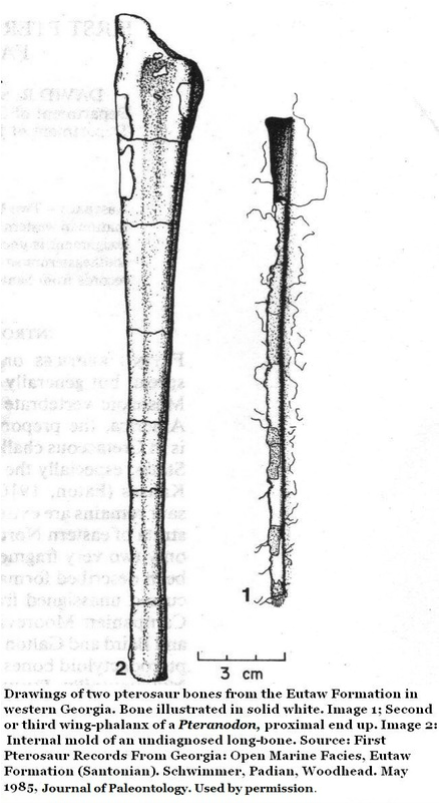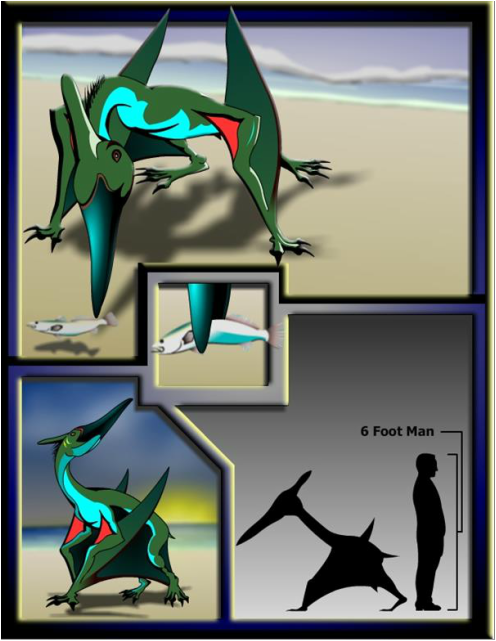7A: Georgia’s Pterosaur, 83 million years ago
By Thomas Thurman
Flying reptiles are rare everywhere but were unknown in Georgia until May 1985, when David Schwimmer from Columbus State University, Kevin Padian from University of California in Berkley and Alfred Woodhead from Martin Army Hospital at Fort Benning, Georgia collaborated to share this unique discovery.
The finds were two isolated bones from deep inside the U.S. Army Base; Fort Benning in West Georgia. The partial bones were recovered two years apart.
When the pterosaurs flew, this would have been an open marine environment. Both fossils came from the Eutaw Formation, which is known for shark’s teeth and vertebrate bones.
These images were created in 2012 by artist Hasani Jones at Georgia Southwestern State University. They represent a pterodactyl of the genus Pteranodon, likely a larger animal that either of the Georgia specimens but certainly present in North America at the same time and very well-known from the fossil record. This genus is known to occur in Alabama, so was very likely present in Georgia as well, though no fossils are confirmed from our state. Hasani represented an adult male, females were a bit smaller. Pteranodons are among the larger pterosaurs.
Pterosaurs are not dinosaurs but flying reptiles and the oldest flying vertebrates. They emerged into the fossil record during the Late Triassic (about 220 million years ago) and ranged in size from the smallest known adult Nemicolopterus crypticus with a wingspan of about 10 inches, or the size of a mocking bird, to the largest pterosaur Quetzalcoatlus with a wingspan of a small plane.
These were active flyers, not just gliders. As a flight adaptation, all pterosaur bones are air filled, thin walled and very lightweight in structure. Flight is achieved through highly modified front limbs covered in three different layers of skin. Pterosaurs were also quadrupeds, meaning that they walked on all four legs; their front legs were adapted into wings. In the case of the two Georgia pterosaur finds, both bones were seemingly partial, isolated examples of phalanx wing bones.
These were active flyers, not just gliders. As a flight adaptation, all pterosaur bones are air filled, thin walled and very lightweight in structure. Flight is achieved through highly modified front limbs covered in three different layers of skin. Pterosaurs were also quadrupeds, meaning that they walked on all four legs; their front legs were adapted into wings. In the case of the two Georgia pterosaur finds, both bones were seemingly partial, isolated examples of phalanx wing bones.

Our pterosaur lived about 83 million years ago and from their positions in the stratigraphy both fossils are probably pterodactyls; which are the later, more advanced of the two pterosaur sub-orders. The pterodactyls emerged during the Middle Jurassic (about 167 million years ago) and are characterized by short tails. Many lacked teeth and had well developed, in some cases elaborate, crests on their heads.
Sample 1 is undoubtedly an incomplete wing phalanx consisting of 6.5 inches of preserved length, part of which is only preserved by impression. Which position it held in the wing is unknown.
Sample 2 is more difficult to diagnose. It is only an internal mold of the original bone with a few bits of bone still clinging to the matrix; again its position in the wing is unknown. It is 8.94 inches long. Its dimensions are unusual for a phalanx bone but this may be an artifact of preservation. By the few actual bits of bone remaining, the original was clearly very thin walled and this is typical a pterosaur. (8)
Sample 1 is undoubtedly an incomplete wing phalanx consisting of 6.5 inches of preserved length, part of which is only preserved by impression. Which position it held in the wing is unknown.
Sample 2 is more difficult to diagnose. It is only an internal mold of the original bone with a few bits of bone still clinging to the matrix; again its position in the wing is unknown. It is 8.94 inches long. Its dimensions are unusual for a phalanx bone but this may be an artifact of preservation. By the few actual bits of bone remaining, the original was clearly very thin walled and this is typical a pterosaur. (8)

Note; in a 02/June/2013 email Dr. Schwimmer reports the following: “Since the paper in 1985 I found a third bone from the same site, same size animal. I now believe all three bones were from a single individual.”
On 24/April/2020 David Schwimmer added a further observation; "I can add one more note: the larger bone in the original paper is the metacarpal IV from the same wing. The other two bones are the 2nd and 3rd phalanges. Cheers."
Paleobiology Database (paleobiodb.org)
A wonderful online tool for research and public use; assembled by a team led by Dr. Mark Uhen, the Paleobiology Database can be used to see the distribution and frequency of species; both vertebrate and invertebrate, I narrowed the search geographically to Georgia.
Using the PBDB Navigator, one can browse by taxa and other terms. Here I shared listing of Eutaw Formation sharks reported in 2001 by Gerard Case and David Schwimmer from Ochilee Creek in Southwest Georgia near the Alabama line. These animals lived between 85.8 and 70.6 million years ago. And would be about the same age as Georgia’s pterosaur finds.
Ochilee Creek, Eutaw Formation in Georgia
Scientific Name Common Name
Borodinopristis Sawfish
Columbusia Shark
Chiloscyllium Bamboo Shark
Cretodus borodini Mackerel Shark family
Cretolamna appendiculata Mackerel Shark family
Erguitaia Ray or Skate
Hybodus Hump Toothed Shark
Ischyrhiza Sawfish
Ischyrhiza mira Sawfish
Lissodus babulskii Sawfish
Microdontaspis Carpet Shark/Wobbegong
Protoplatyrhina renae Skate
Pseudohypolophus Guitarfish
Ptychodus mortoni Extinct Shark (ate mollusks?)
Ptychotrygon Sawfish
Ptychotrygon triangularis Sawfish
Scapanorhynchus rhaphiodon Spadesnout or Goblin Shark
Squalicorax falcatus Mackerel Shark family
Squatina hassei Angel Shark
Source;
Stratigraphy Eutaw Fm.
Time frame; Early Santonian - Middle Santonian
Reference;
G. R. Case and D. R. Schwimmer. 2001. A New Selachian Fauna From the Eutaw Formation (Upper Cretaceous/Early to Middle Santonian) of Chattahoochee County, Georgia. Palaeontographica Abteilung A 261(Lfg. 4-6):83-102
These images were created in 2012 by artist Hasani Jones at Georgia Southwestern State University. They represent a pterodactyl of the genus Pteranodon, likely a larger animal that either of the Georgia specimens but certainly present in North America at the same time and very well-known from the fossil record. This genus is known to occur in Alabama, so was very likely present in Georgia as well, though no fossils are confirmed from our state. Hasani represented an adult male, females were a bit smaller. Pteranodons are among the larger pterosaurs.
References:
First Pterosaur Records from Georgia: Open Marine Facies, Eutaw Formation (Santonian). David R. Schwimmer, Kevin Padian and Alfred B. Woodhead. Journal of Paleontology, V.59, No. 3, P.674-676, May 1985
On 24/April/2020 David Schwimmer added a further observation; "I can add one more note: the larger bone in the original paper is the metacarpal IV from the same wing. The other two bones are the 2nd and 3rd phalanges. Cheers."
Paleobiology Database (paleobiodb.org)
A wonderful online tool for research and public use; assembled by a team led by Dr. Mark Uhen, the Paleobiology Database can be used to see the distribution and frequency of species; both vertebrate and invertebrate, I narrowed the search geographically to Georgia.
Using the PBDB Navigator, one can browse by taxa and other terms. Here I shared listing of Eutaw Formation sharks reported in 2001 by Gerard Case and David Schwimmer from Ochilee Creek in Southwest Georgia near the Alabama line. These animals lived between 85.8 and 70.6 million years ago. And would be about the same age as Georgia’s pterosaur finds.
Ochilee Creek, Eutaw Formation in Georgia
Scientific Name Common Name
Borodinopristis Sawfish
Columbusia Shark
Chiloscyllium Bamboo Shark
Cretodus borodini Mackerel Shark family
Cretolamna appendiculata Mackerel Shark family
Erguitaia Ray or Skate
Hybodus Hump Toothed Shark
Ischyrhiza Sawfish
Ischyrhiza mira Sawfish
Lissodus babulskii Sawfish
Microdontaspis Carpet Shark/Wobbegong
Protoplatyrhina renae Skate
Pseudohypolophus Guitarfish
Ptychodus mortoni Extinct Shark (ate mollusks?)
Ptychotrygon Sawfish
Ptychotrygon triangularis Sawfish
Scapanorhynchus rhaphiodon Spadesnout or Goblin Shark
Squalicorax falcatus Mackerel Shark family
Squatina hassei Angel Shark
Source;
Stratigraphy Eutaw Fm.
Time frame; Early Santonian - Middle Santonian
Reference;
G. R. Case and D. R. Schwimmer. 2001. A New Selachian Fauna From the Eutaw Formation (Upper Cretaceous/Early to Middle Santonian) of Chattahoochee County, Georgia. Palaeontographica Abteilung A 261(Lfg. 4-6):83-102
These images were created in 2012 by artist Hasani Jones at Georgia Southwestern State University. They represent a pterodactyl of the genus Pteranodon, likely a larger animal that either of the Georgia specimens but certainly present in North America at the same time and very well-known from the fossil record. This genus is known to occur in Alabama, so was very likely present in Georgia as well, though no fossils are confirmed from our state. Hasani represented an adult male, females were a bit smaller. Pteranodons are among the larger pterosaurs.
References:
First Pterosaur Records from Georgia: Open Marine Facies, Eutaw Formation (Santonian). David R. Schwimmer, Kevin Padian and Alfred B. Woodhead. Journal of Paleontology, V.59, No. 3, P.674-676, May 1985

